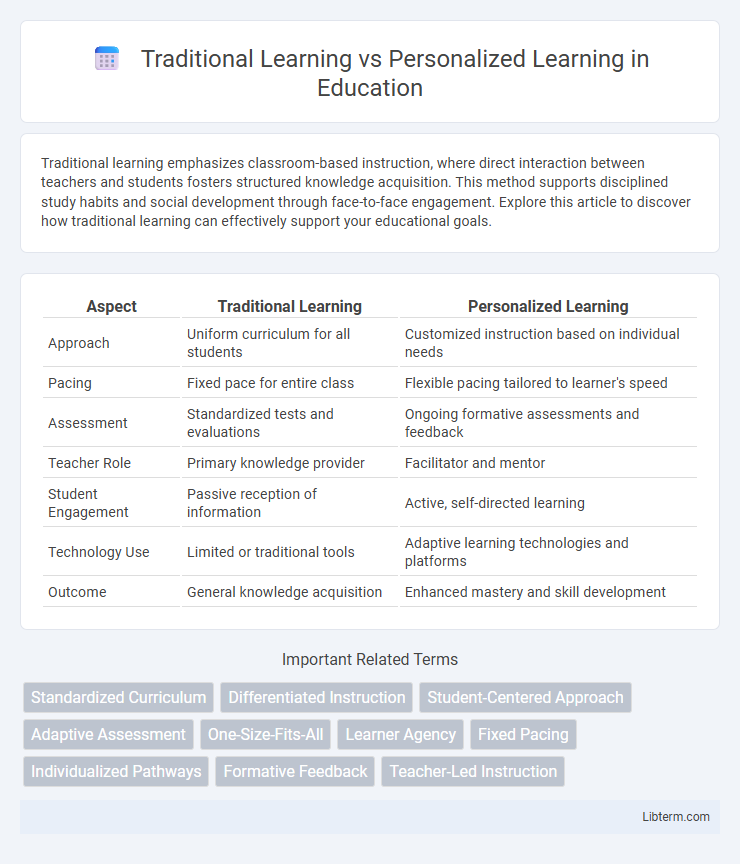Traditional learning emphasizes classroom-based instruction, where direct interaction between teachers and students fosters structured knowledge acquisition. This method supports disciplined study habits and social development through face-to-face engagement. Explore this article to discover how traditional learning can effectively support your educational goals.
Table of Comparison
| Aspect | Traditional Learning | Personalized Learning |
|---|---|---|
| Approach | Uniform curriculum for all students | Customized instruction based on individual needs |
| Pacing | Fixed pace for entire class | Flexible pacing tailored to learner's speed |
| Assessment | Standardized tests and evaluations | Ongoing formative assessments and feedback |
| Teacher Role | Primary knowledge provider | Facilitator and mentor |
| Student Engagement | Passive reception of information | Active, self-directed learning |
| Technology Use | Limited or traditional tools | Adaptive learning technologies and platforms |
| Outcome | General knowledge acquisition | Enhanced mastery and skill development |
Introduction to Traditional and Personalized Learning
Traditional learning typically involves a structured classroom environment with a fixed curriculum and standardized teaching methods designed for a broad student audience. Personalized learning adapts instructional content, pacing, and assessment to meet individual students' needs, preferences, and learning styles using technology and data-driven insights. This approach enhances student engagement and improves learning outcomes by tailoring education to each learner's unique strengths and challenges.
Defining Traditional Learning: Core Features
Traditional learning is characterized by structured classroom settings, standardized curricula, and teacher-centered instruction prioritizing uniform content delivery. It emphasizes memorization, fixed pacing, and assessment through examinations to evaluate student performance. This approach primarily supports group learning dynamics with limited customization to individual student needs or learning styles.
What Is Personalized Learning? Key Characteristics
Personalized learning tailors educational experiences to individual student needs, preferences, and learning pace, unlike traditional learning which follows a uniform curriculum. Key characteristics include adaptive content, student-centered goals, continuous assessment, and flexible learning pathways that leverage technology to optimize engagement and mastery. This approach promotes deeper understanding by accommodating diverse learning styles and providing targeted support.
Historical Evolution of Learning Approaches
Traditional learning, rooted in ancient oral traditions and later formalized during the establishment of early academies like Plato's Academy, emphasized standardized curricula and teacher-centered instruction. Over centuries, educational paradigms shifted with the rise of progressive education in the 20th century, promoting student-centered approaches and the recognition of individual learning differences. The evolution toward personalized learning gained momentum with advances in educational psychology and technology, enabling adaptive learning systems that tailor instruction to individual cognitive styles and pacing.
Student Engagement: Comparing Both Methods
Traditional learning often follows a fixed curriculum and uniform teaching pace, which can limit student engagement by not addressing individual interests or learning styles. Personalized learning tailors content, pace, and instructional methods to each student's unique needs, significantly boosting motivation and active participation. Research shows that adaptive learning platforms and one-on-one mentorship in personalized settings increase student engagement metrics, such as time-on-task and knowledge retention, compared to traditional classroom environments.
Teacher Roles in Traditional vs Personalized Learning
In traditional learning, the teacher serves as the primary source of knowledge, leading instruction and maintaining control of the classroom environment. In personalized learning, the teacher acts as a facilitator and coach, tailoring instruction to individual student needs and fostering self-directed learning. This shift redefines the teacher's role from content deliverer to learner advisor and mentor, emphasizing adaptability and student engagement.
Technology’s Influence on Learning Methods
Technology has transformed Traditional Learning by integrating digital tools such as interactive whiteboards and online assessments, enhancing engagement and accessibility. Personalized Learning leverages adaptive software and data analytics to tailor educational content to individual student needs, promoting deeper understanding and retention. The shift towards technology-driven methods enables real-time feedback and differentiated instruction, significantly improving learning outcomes.
Measuring Student Success and Outcomes
Measuring student success in traditional learning often relies on standardized testing and uniform assessments, which may not fully capture individual progress or diverse skills. Personalized learning utilizes data analytics and adaptive assessments to monitor each student's growth, enabling tailored feedback and targeted interventions. This approach enhances outcome accuracy by aligning evaluation methods with individual learning paths and competency development.
Pros and Cons of Each Learning Approach
Traditional learning provides a structured curriculum with standardized assessments, promoting consistent knowledge acquisition but may limit individual creativity and pace. Personalized learning adapts to students' unique strengths and interests, enhancing engagement and retention, though it requires significant resources and may create challenges in measuring progress uniformly. Both approaches have distinct advantages and drawbacks, with traditional models excelling in uniformity and personalized methods excelling in customized educational experiences.
Future Trends in Education: Blending Both Models
Future trends in education emphasize blending traditional learning's structured curriculum with personalized learning's adaptive techniques to enhance student engagement and outcomes. Integrating AI-driven analytics and adaptive learning technologies supports tailored instruction while maintaining a cohesive classroom environment. This hybrid approach aims to balance standardized assessments with individualized feedback, fostering both academic rigor and personalized growth.
Traditional Learning Infographic

 libterm.com
libterm.com